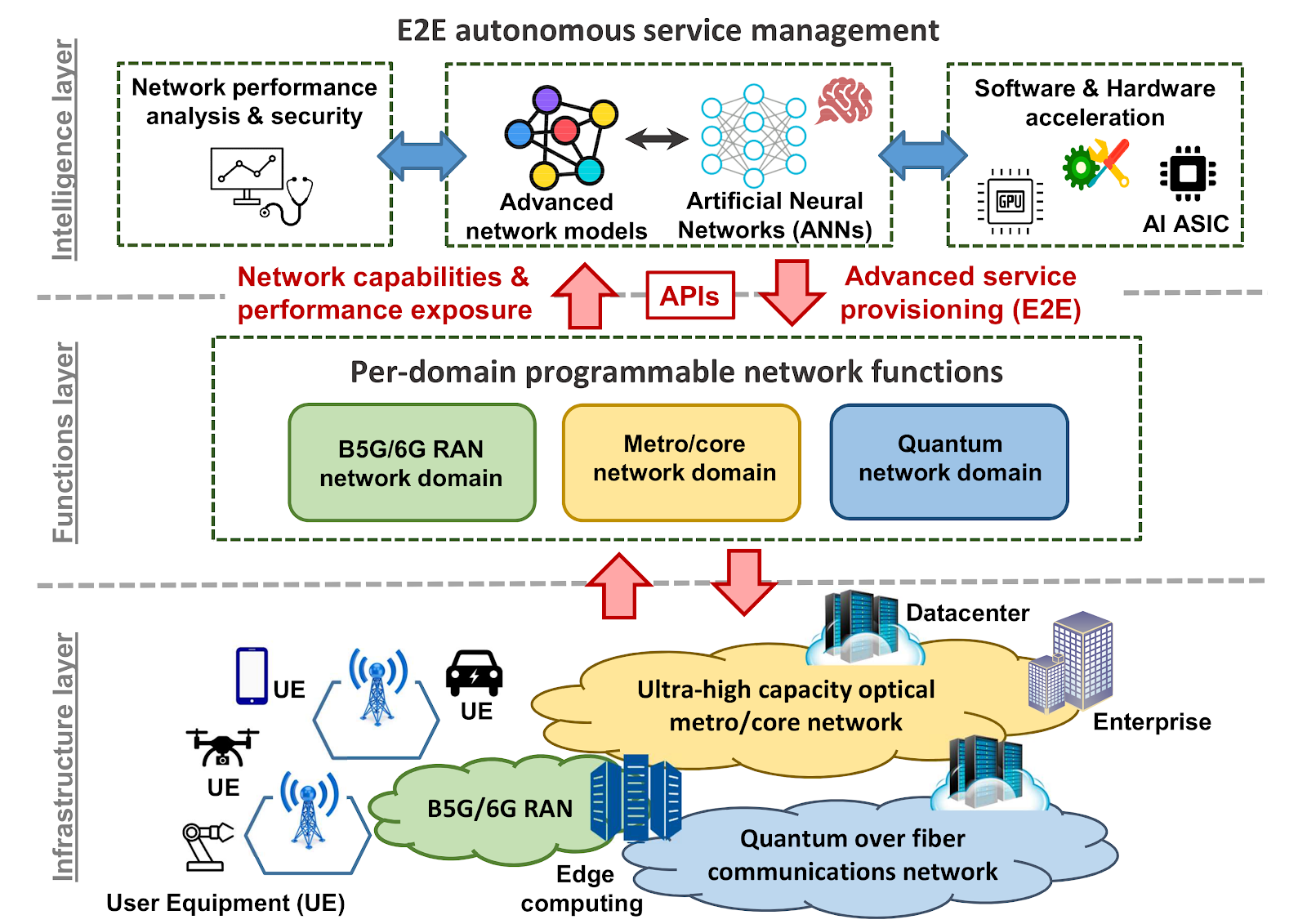BLOSSOMS: Beyond 5G network infrastructure Leveraging deep AI acrOSS ultra-high capacity Optical data transport and quantuM physical Substrates
The fifth generation (5G) of mobile network infrastructures is already being successfully deployed in many countries around the world. In parallel, huge research efforts are beginning to be undertaken to drive the deployment of its successor 6G by 2030, in order to meet the needs of information and communications technologies (ICT) in the coming years. It is envisioned that telecommunications networks beyond 5G (B5G) and 6G will connect the human, physical and digital worlds, bringing to the forefront a host of new disruptive applications, including immersive virtual/augmented reality, holographic-type communications or the so-called tactile Internet. However, much stricter key performance indicators (KPIs) are set for B5G/6G networks compared to their 5G predecessor technology. And to effectively meet them, a redesign of the current 5G network architecture, along with the introduction of new enabling network technologies, emerge as important requirements.
In this context, BLOSSOMS aims to design an intelligent network architecture capable of providing advanced network services in future B5G/6G network scenarios in a fully autonomous way. The reference network architecture will be organized in three well separated layers: infrastructure, functions and network intelligence. At the bottom, the network infrastructure layer will encompass heterogeneous B5G/6G radio access (B5G/6G-RAN), ultra-high capacity optical metro/core and quantum communications network segments. The middle layer of the architecture will include per-domain programmable network functions deployed in the cloud. And on top of that will reside the network intelligence layer, based on advanced AI techniques to achieve a fully autonomous network. The proposed activities within the BLOSSOMS project will serve to propose and evaluate many of the enabling technologies and solutions to realize the envisioned B5G/6G network architecture. This will be achieved by leveraging the extensive experience of the project research team members in the application of advanced machine learning and monitoring techniques, quantum, optical and radio data transport technologies, as well as programmable network architectures. In this way, we expect that the results achieved during the execution of the project will represent a significant advance towards the successful materialization of future B5G/6G telecommunication networks.


Website:
blossoms.upc.edu
Project Type:
Spanish Ministry Grant
Funding:
275 K€
Duration:
2025-2027
BLOSSOMS: Beyond 5G network infrastructure Leveraging deep AI acrOSS ultra-high capacity Optical data transport and quantuM physical Substrates
Website:
blossoms.upc.edu
Project Type:
Spanish Ministry Grant
Funding:
275 K€
Duration:
2025-2027
The fifth generation (5G) of mobile network infrastructures is already being successfully deployed in many countries around the world. In parallel, huge research efforts are beginning to be undertaken to drive the deployment of its successor 6G by 2030, in order to meet the needs of information and communications technologies (ICT) in the coming years. It is envisioned that telecommunications networks beyond 5G (B5G) and 6G will connect the human, physical and digital worlds, bringing to the forefront a host of new disruptive applications, including immersive virtual/augmented reality, holographic-type communications or the so-called tactile Internet. However, much stricter key performance indicators (KPIs) are set for B5G/6G networks compared to their 5G predecessor technology. And to effectively meet them, a redesign of the current 5G network architecture, along with the introduction of new enabling network technologies, emerge as important requirements.
In this context, BLOSSOMS aims to design an intelligent network architecture capable of providing advanced network services in future B5G/6G network scenarios in a fully autonomous way. The reference network architecture will be organized in three well separated layers: infrastructure, functions and network intelligence. At the bottom, the network infrastructure layer will encompass heterogeneous B5G/6G radio access (B5G/6G-RAN), ultra-high capacity optical metro/core and quantum communications network segments. The middle layer of the architecture will include per-domain programmable network functions deployed in the cloud. And on top of that will reside the network intelligence layer, based on advanced AI techniques to achieve a fully autonomous network. The proposed activities within the BLOSSOMS project will serve to propose and evaluate many of the enabling technologies and solutions to realize the envisioned B5G/6G network architecture. This will be achieved by leveraging the extensive experience of the project research team members in the application of advanced machine learning and monitoring techniques, quantum, optical and radio data transport technologies, as well as programmable network architectures. In this way, we expect that the results achieved during the execution of the project will represent a significant advance towards the successful materialization of future B5G/6G telecommunication networks.

